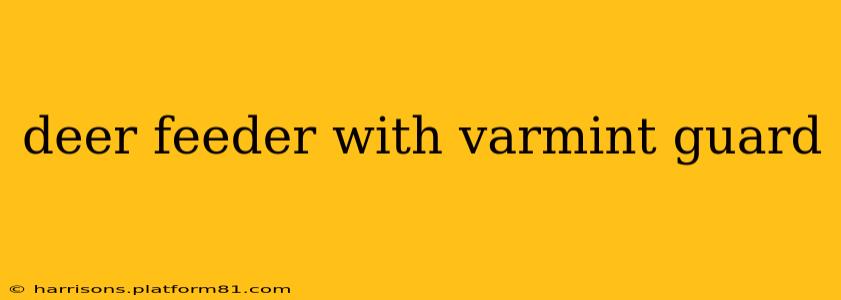Attracting deer to your property can be a rewarding experience, offering exciting wildlife viewing opportunities. However, deer feeders, while beneficial, often attract unwanted guests – varmints like raccoons, squirrels, and other critters that can deplete your feed supply and potentially damage the feeder itself. That's where deer feeders with varmint guards come in. This comprehensive guide explores the world of deer feeders equipped with these crucial protective features, helping you choose the right one for your needs.
What is a Varmit Guard on a Deer Feeder?
A varmint guard is a crucial component of a deer feeder designed to prevent smaller animals from accessing the feed. These guards employ various mechanisms, including:
- Cone-shaped guards: These create a barrier that's easily accessible to deer but difficult for smaller animals to navigate.
- Metal cages or screens: These surround the feeding area, restricting access to only larger animals.
- Spinning baffle systems: These utilize rotating plates or cones to deter smaller animals while allowing deer to feed.
Choosing the right varmint guard depends on the specific challenges of your location and the types of varmints you encounter.
What are the Different Types of Deer Feeders with Varmit Guards?
Deer feeders come in a variety of styles, each offering different features and benefits. Understanding these types is key to selecting the optimal feeder for your circumstances:
1. Gravity Feeders with Varmit Guards
Gravity feeders dispense feed through a gravity-controlled mechanism. The addition of a varmint guard prevents smaller animals from reaching the feed while allowing deer to access it easily. These are often a popular choice due to their simplicity and reliability.
2. Spinner Feeders with Varmit Guards
Spinner feeders distribute feed using a rotating mechanism, typically triggered by a timer or sensor. These often incorporate elaborate varmint guard systems that can be more effective at deterring persistent critters than simpler gravity feeders.
3. Tripod Feeders with Varmit Guards
Tripod feeders are characterized by their three-legged support structure, offering stability and durability. These are frequently paired with sturdy varmint guards to protect the feed against persistent varmints.
4. Hanging Feeders with Varmit Guards
Hanging feeders suspend the feed from a tree or other high point. These are often lighter and easier to fill but need a sturdy hanging point, and the varmint guard design must accommodate the suspension method.
How to Choose the Right Deer Feeder with a Varmint Guard?
Choosing the best deer feeder depends on several factors:
- Type of varmints: Identify the predominant varmints in your area. A simple cone guard might suffice for squirrels, while raccoons may require a more robust metal cage.
- Feed capacity: Consider how much feed you need to dispense and how frequently you can refill the feeder.
- Ease of filling and maintenance: Some feeders are easier to fill and clean than others.
- Durability and weather resistance: Choose a feeder that can withstand the elements in your region.
- Budget: Feeders range significantly in price, so establish a budget beforehand.
What Size Varmit Guard Do I Need?
The size of the varmint guard should be appropriate for the size of the deer in your area and the size of the varmints you are trying to deter. Too small, and deer may struggle; too large, and varmints may still find access. Always check manufacturer specifications for recommendations.
What Kind of Feed Works Best in a Deer Feeder with a Varmit Guard?
While the type of feed is not directly influenced by the varmint guard, choosing the correct feed is vital to attracting deer. Consider using high-quality deer feed formulated for the time of year and deer’s nutritional needs.
How Often Should I Refill My Deer Feeder?
The refill frequency depends on factors such as the number of deer, the feeder capacity, and the type of feed. Regularly monitor your feeder and refill as needed to maintain a consistent supply.
How Do I Maintain My Deer Feeder with a Varmit Guard?
Regular maintenance, including cleaning and inspection of the varmint guard, is essential to ensure the feeder's proper function and longevity. Check for damage, rust, or any signs of wear. Clean debris to prevent feed spoilage.
By carefully considering these factors and selecting a deer feeder with an effective varmint guard, you can successfully attract and feed deer while minimizing the impact of unwanted visitors. Remember, a well-chosen feeder is a key element in a successful wildlife management strategy.
